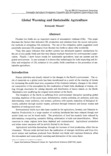Global Warming and Sustainable Agriculture
JIRCAS international symposium series
| ISSN | 13406108 |
|---|---|
| NII recode ID (NCID) | AA1100908X |

Full text
intlsymp-6_83-98.pdf504.85 KB
Flooded rice fields are an important source of atmospheric methane (CH4). This paper discusses the factors that influence CH4, production and emission from the source and potential methods of mitigating CH4 emissions. The use of the mitigation option suggested could potentially decrease CH4 emission from flooded rice fields by about 40% worldwide.
Then, this paper indicates that modern science has developed superior mechanisms for the use of rice paddy fields and that they display multiple functions for environmental conservation. Finally, I show future trends for sustainable agriculture, land use system and the global environment. In one example it is shown that technologies for both improving soil fertility and mitigation of CH4 emission in· rice paddy fields contribute to the promotion of sustainable agriculture.
Then, this paper indicates that modern science has developed superior mechanisms for the use of rice paddy fields and that they display multiple functions for environmental conservation. Finally, I show future trends for sustainable agriculture, land use system and the global environment. In one example it is shown that technologies for both improving soil fertility and mitigation of CH4 emission in· rice paddy fields contribute to the promotion of sustainable agriculture.
| Creator | Katsuyuki Minarni |
|---|---|
| Publisher | Japan International Research Center for Agricultural Sciences |
| Available Online | |
| Issue | 6 |
| spage | 83 |
| epage | 98 |
| Language | eng |
